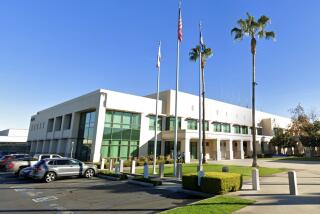Trial in 50-shot killing starts
- Share via
QUEENS, N.Y. -- — On the steps of the courthouse, a man handed out buttons emblazoned with a bullet wound and a number. Protesters waved placards carrying the same number and counted in unison until they reached the figure at the heart of this case: 50.
That is how many bullets undercover police officers fired at Sean Bell, killing the unarmed 23-year-old after his bachelor party at a Queens nightclub in November 2006.
Two of the officers involved in the shooting went on trial for manslaughter Monday. Michael Oliver, who fired 31 times, and Gescard F. Isnora, who fired 11 shots, are accused of first- and second-degree manslaughter. If convicted, they could serve up to 25 years in prison.
A third officer, Marc Cooper, is being tried separately for reckless endangerment. Two officers who fired three shots or fewer were not indicted.
Angry observers said the shooting was a familiar New York story of police brutality against blacks.
But the prosecutor of the two police officers called it bad police work, and a crime.
“The story of how this tragedy occurred is a tale of carelessness verging on incompetence,” said Assistant Dist. Atty. Charles Testagrossa in his opening statement. “When the court has heard all the testimony in this case it will be clear that what happened cannot be explained away as a mere accident or mistake, but can only be characterized as criminal.”
On Nov. 24, 2006, a group of Bell’s friends threw him a last-minute bachelor party at Club Kalua, a local strip club.
Around 4 a.m., Bell and several of his friends, including Joseph Guzman and Trent Benefield, were headed by car for breakfast at a local diner. New York undercover officers, conducting a sting operation at Club Kalua that night, confronted Bell outside the club, although the testimony varied about what happened.
What is clear is that Bell hit one of the officers with the car he was driving, although he didn’t knock him over. A barrage of bullets followed, killing Bell and severely injuring Guzman and Benefield.
A security guard at the club, Sean Spencer, 39, testified that he heard two distinct bursts of gunfire 10 to 15 seconds apart that November night.
One issue in the trial is whether the officers paused and reassessed, as they are instructed to do, after three shots. But James J. Culleton, Oliver’s attorney, said, “The fundamental flaw in the people’s case is its fixation on the number of shots.”
Oliver believed the officers were under attack and responded, Culleton said. “There was no defining moment. Nothing happened that should have caused my client or could have caused my client to realize that deadly physical force was no longer necessary,” he said.
The case is being heard by State Supreme Court Judge Arthur J. Cooperman. The officers waived a jury trial, fearing that any Queens jury would be biased because of extensive media coverage of the case.
In the past, high-profile shootings of citizens by police have pitted community leaders against City Hall. In 1999, an unarmed African immigrant, Amadou Diallo, was killed outside his home in the Bronx by four officers who fired 41 shots. The shooting and subsequent acquittal of the officers stirred anger.
After the shooting of Bell, New York Mayor Michael R. Bloomberg quickly reached out to activists and community leaders, saying police used “excessive force” and calling for calm in the city.
“This is about a man who died in a hail of 50 bullets,” said Michael Hardy, a lawyer representing Bell’s fiance Nicole Paultre-Bell.
The trial is expected to last several weeks.
Times staff writer Jenny Jarvie contributed to this report.
More to Read
Sign up for Essential California
The most important California stories and recommendations in your inbox every morning.
You may occasionally receive promotional content from the Los Angeles Times.












